
The European market potential for dried mushrooms
Long term, the European market for dried mushrooms is expected to grow in a stable way. This growth is likely to be caused by changes in European consumers’ consumption patterns. This includes interest in immune-boosting food and animal-protein replacements growing. Italy, Germany and France offer the most opportunities for developing-country suppliers.
Contents of this page
1. Product description
Dried mushrooms are the result of drying fresh mushrooms. They can be sun-dried or air-dried by a flow of hot air in specially constructed tunnels. They can be dried whole or cut to the desired shape and then dried. Dried mushrooms can also be ground into powder. They can be produced from frozen mushrooms in vacuum freeze dryers. On average, you need around 10 kg of fresh mushrooms to produce 1 kg of dried mushrooms, but this depends on the type of mushroom and other external factors.
Dried mushrooms are not intended for immediate consumption but as an ingredient after rehydration. They are mainly used in home cooking (for example, for soups and risottos), as an ingredient in dehydrated meals and spices, and in healthy food and pharmacy products. After being soaked in water, they can be prepared in a similar way as fresh mushrooms. One peculiar quality of dried mushrooms is that the intensity of their flavour increases after drying.
There is no official trade classification for dried mushrooms as trade consists of many mushroom species. However, they can be classified into 3 groups according to the main European market segments:
- Gourmet dried mushrooms – mostly used in European cuisine. Typical examples are porcini (Boletus), chanterelle (Cantharellus), morels (Morchella), trumpets (Craterellus), oyster mushrooms (Pleurotus) and truffles (many species).
- Asian dried mushrooms – used in Asian cuisine. Typical examples are Shiitake (Lentinula), eringi (Pleurotus eryngii), mu-err, which is also known as black fungus or wood ear (Auricularia), maitake (Grifola), white fungus, which is also known as jelly fungus (Tremella) and straw mushroom (Volvariella).
- Medical mushrooms –mostly used as dietary supplements. Examples include chaga (Inonotus obliquus), reishi (Ganoderma lingzhi), cordyceps (Cordyceps militaris), lion’s mane (Hericium erinaceus) and himematsutake (Agaricus blazei).
Please note that the above description is not the official classification: it is the common terminology used in the market. Some categories overlap. For example, shiitake and maitake are used in Asian cooking and also as medical mushrooms. Some Asian mushrooms are also grown worldwide (such as shiitake) or can be found in nature on other continents (such as matsutake).
Figure 1: Dried porcini mushroom (European gourmet mushroom)

Source: Autentika Global
Figure 2: Dried matsutake mushroom (Asian gourmet mushroom, specialty in Japanese cuisine)
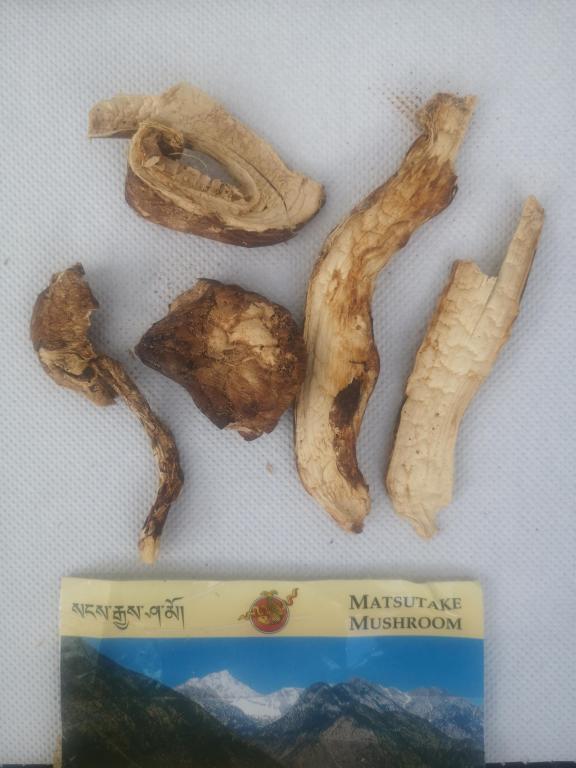
Source: Autentika Global
Figure 3: Dried shiitake (Asian and medical mushroom)
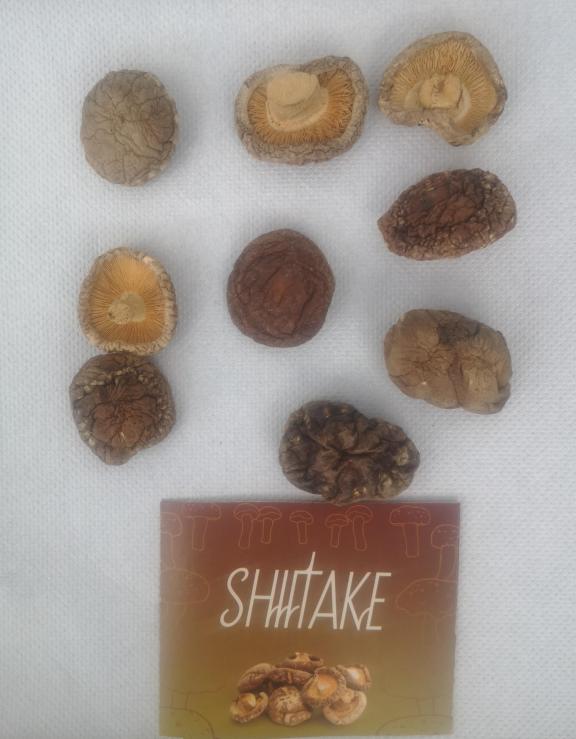
Source: Autentika Global
This study covers general information regarding the dried mushroom market in Europe that is of interest to producers in developing countries. When this study refers to ‘Europe’, it includes the 27 member states of the European Union (EU), plus the United Kingdom, Switzerland, Norway, Iceland and Liechtenstein. Developing countries are all countries that are listed as official development assistance recipients. For statistical analysis, the following combined nomenclature codes are used:
|
Combined Nomenclature Number |
Product |
|
071231 |
Dried mushrooms of the ‘Agaricus’ genus, whole, cut, sliced, broken or in powder but not further prepared |
|
071232 |
Dried wood ears ‘Auricularia spp.’, whole, cut, sliced, broken or in powder but not further prepared |
|
071233 |
Dried jelly fungi ‘Tremella spp.’, whole, cut, sliced, broken or in powder but not further prepared |
|
071234 |
Dried shiitake ‘Lentinus edodes’, whole, cut, sliced, broken or in powder but not further prepared’ |
|
071239 |
Other dried mushrooms and truffles, whole, cut, sliced, broken or in powder but not further prepared |
Please note that the statistical code for dried shiitake has been added to the official 2022 trade classification.
2. What makes Europe an interesting market for dried mushrooms?
Europe shows a constant demand for dried mushrooms due to the variety of the different market segments. However, the import of medical dried mushrooms has been much stronger over the last 3 years. This high demand was caused by the outbreak of the COVID-19 pandemic in 2020. The COVID-19 pandemic increased global demand for immunity-boosting food and food supplements. This includes dried and powdered mushrooms, such as reishi, cordyceps, chaga and shiitake.
Europe is also an attractive market as it generally offers higher import prices compared to Asian markets. Some gourmet mushrooms (such as porcini) are also more used in the European cuisine compared to other world cuisines. This provides opportunities for suppliers of quality gourmet mushrooms. Dried mushrooms are also frequently used as an ingredient in Asian restaurants across Europe. Finally, dried mushrooms are an ingredient in the food processing and food supplements industry.
Europe is increasing its global market share of dried mushrooms. Currently, Europe accounts for around 20% of the world’s dried mushroom market. European dried mushroom imports reached 11,000 tonnes in 2022, worth €205 million. More than 60% of the European dried mushroom trade consists of import from developing countries.
In 2022, more than 80% of the value of European imports consisted of gourmet and medical mushrooms. Dried mushrooms of the genus Agaricus accounted for 10% of imports, followed by ‘dried wood ears’ types (5%), dried shiitake (3%) and Tremella genus (1%).
In the next 5 years, the European market for dried mushrooms is likely to increase, at an annual growth rate of 1-3%. The import growth of dried medical mushrooms (food supplements category) will be even higher, driven by increasing demand for immunity-boosting food. Larger fluctuations in the import of wild-harvested mushrooms are also expected, due to climate change. During the wet season, the offer and imported quantities will be higher.
Source: Autentika Global
3. Which European countries offer the most opportunities for dried mushrooms?
The European market for dried mushrooms is diverse because none of the leading importing countries have dominance in imports. The 3 biggest importers (the Netherlands, Germany and France) often switch their ranking in import quantities. The 6 countries with the most opportunities for dried mushrooms are Italy, Germany, France, the Netherlands, the United Kingdom and Poland.
In terms of imported quantities, Italy was the largest European importer of dried mushrooms in 2022, representing 19% of all imported mushrooms. It was closely followed by Germany (18%), France (15%), the Netherlands (12%) and the United Kingdom (11%). However, in terms of value, the ranking of the leading importers is different. The Netherlands, which is the highest importer in terms of quantity, is ranked fourth in value. This is because it imports high quantities of dried cultivated mushrooms from Poland, due to their relatively low price.
France and Italy offer opportunities for suppliers of wild-harvested gourmet mushrooms, as both countries use dried mushrooms in traditional home cooking. The Netherlands is the leading European import market for Asian mushrooms. Germany offers opportunities in several market segments, including spices and dehydrated soups. The United Kingdom is an important market for medical mushrooms and food supplements. Together with Poland, these 6 countries offer the most opportunities for dried mushrooms in Europe.
Source: ITC TradeMap
Italy: dried porcini specialist
The most popular dried mushroom in Italy is porcini. It represents more than 80% of Italy’s dried mushroom imports. Porcini mushrooms’ flavour intensifies after drying. It is a prized ingredient in many Italian dishes, such as soups, sauces and risotto. Due to their cheaper price and the cultivation technology, most dried porcini is imported from China. Wild-harvested dried porcini is mostly imported from Eastern Europe to complement Italy’s own production.
In 2022, Italy imported more than 2,000 tonnes of dried mushrooms with a value of €42.6 million. Italy also exported more than 700 tonnes of dried mushrooms. In 2022, Italy imported 44% of its dried mushrooms from China, followed by Romania (18%), Bulgaria (13%), Croatia (7%) and Poland (5%). Romania is gaining most of the market share on the Italian market. Imports of dried mushrooms (mostly porcini) to Italy from Romania doubled from 200 tonnes in 2008 to 400 tonnes in 2022.
Dried mushrooms in Italy are sold mostly by private supermarket labels, such as Coop, Conad, Crai and Carrefour. Examples of independent brands include Asiago, Naturbosco, Demetra, Flotei and Lunelli. Italy is also home to 1 of the largest groups of truffle mushrooms consumers and traders in Europe.
Germany: a variety of market segments
Germany is a large market for different types of mushrooms. Like Italy, Germany imports a large share of dried porcini from China, but it also imports a variety of other mushrooms too. Asian dried mushrooms are sold to diverse ethnic retailers (such as GoAsia) and to suppliers of Asian restaurants. Organic and medical mushrooms are also sold through specialised organic and health food retailers like Biomarkt, DM and Alnatura. Powdered medical mushrooms are a growing segment; retailers include Raab Vitalfood, Vita World and Mycovital.
Over the last 5 years, the import of dried mushrooms to Germany increased at an annual rate of 1%. In 2022, the import reached almost 2,000 tonnes, worth €33 million. In 2022, Germany imported 51% of its dried mushrooms from China, followed by Peru (16%), Poland (11%), Italy (5%) and Vietnam (5%). Peru is quickly gaining a larger market share. Since 2018, Germany has increased imports of dried mushrooms from Peru fivefold from 63 tonnes in 2018 to 327 tonnes in 2022.
Most dried mushrooms in German mainstream supermarkets are supplied by companies that also sell fresh mushrooms. Notable examples of suppliers include Pilze Wohlrab, Niklas and RPZ. Dried mushrooms are also sold by spice companies such as Fuchs or Wagner Gewürze. Some German companies have developed their own brands within the Asian food segment, including dried mushrooms, such as Bamboo Garden (by Theodor Kattus) and Diamond (by Kreyenhop & Kluge).
Figure 6: Example of a dried porcini brand in Germany (Niklas)
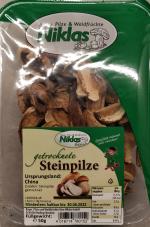
Source: Photo by elemka per Open Food Facts
Figure 7: Example of a dried mushroom private label in Germany (by ALDI)
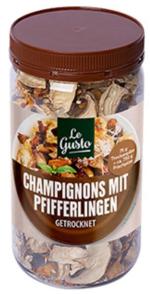
Source: Photo by prepperapp per Open Food Facts
France: morel enthusiasts
French consumers purchase different types of gourmet mushrooms, but dried morels are especially popular. Dried morels are much more expensive compared to other imported dried mushrooms. This is why France has a much higher import value than other European countries. Although many dried morels are collected and produced in France, they are also imported from China. The culture of eating luxury gourmet mushrooms, such as morels or black truffles, is well-developed in France, providing opportunities for export.
In terms of quantity, France is the third-largest European market for dried mushrooms in Europe, but the first in terms of value. Over the last 5 years, imports of dried mushrooms to France have increased at an annual rate of 5%, reaching 1,900 tonnes in 2022, worth €45.7 million. In 2022, France imported 62% of its dried mushrooms from China, followed by Peru (11%), Poland (9%), the Netherlands (3%) and Romania (2%). The largest import increase came from Peru, the Netherlands and Italy.
Dried mushrooms are often sold as private labels (retail chain brands), such as Carrefour (Carrefour Selection and Carrefour bio labels), Leclerc (Notre Jardin label) and Auchan (Mmm! Label). Borde and Sabarot are notable independent brands. France also imports large quantities of Asian mushrooms, which are mainly sold in ethnic shops and supermarkets (such as Tang Frères). The largest share of imported Asian dried mushrooms accounts for different types of Auricularia genus.
Figure 8: A private label for dried morel (by Super U)
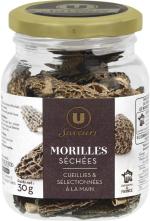
Source: kiliweb per Open Food Facts
The Netherlands: a trade hub
The Netherlands imports significant quantities of dried mushrooms. However, most of the imports are not consumed within the country. Instead, it acts as a transit country for other European destinations. The Netherlands is a significant producer and processor of fresh button mushrooms. The Dutch company Scelta Mushrooms has developed innovative mushroom flavour enhancers and health ingredients based on button mushrooms.
Over the last 5 years, Dutch imports of dried mushrooms fluctuated, reaching 777 tonnes in 2022. During the same period, the value of imports decreased from €11.3 million to €8.6 million. This decrease in value is explained by increased imports of cheaper mushrooms from China. On the other hand, the imports of more expensive mushrooms from Poland decreased. In 2022, the Netherlands imported 45% of dried mushrooms from China, followed by Germany (24%), France (11%), Italy (9%) and Vietnam (2%).
The high ratio of imports from Germany is explained by the presence of German companies (such as Worlée) in the Netherlands. Significant quantities are sold as ingredients for dehydrated soups. Examples of private labels of Dutch retail chains include Asian dried mushrooms (Aldi, Asia Green Garden label) and porcini dried mushrooms (Jumbo, Jumbo label). Dried mushrooms in the Netherlands are also sold by spice companies (such as Euroma), by Mediterranean brand suppliers (such as Enrico Food) and Asian food suppliers (such as Oriental Merchant).
The United Kingdom: a large number of small traders
The British dried mushroom market is characterised by the presence of a large number of traders covering many different market segments. A large market segment are traders of Asian mushrooms which accounts to up to half of the total dried mushroom imports. Examples of Asian dried mushroom traders include Day In Supermarket, SeeWoo and Interlink Direkt or Lovering Foods.
2 leading suppliers of dried mushrooms in the United Kingdom are Leathams (brands Mechant Gourmet and Chefs Brigade) and RH Amar (brand Cooks&Co). The dried mushroom market in the United Kingdom is also served by fine food suppliers (such as Albion Fine Foods or Classic Fine Foods) and Mediterranean food suppliers (such as Bonta Italia). The United Kingdom is also an interesting market for mushroom food supplements. Food supplement suppliers include Aneid, Naturya, Balance Healthcare and Cambridge Commodities.
In 2022, the United Kingdom imported 647,000 tonnes of dried mushrooms, with a value of €11 million. Most imported dried mushrooms are consumed within the country. In 2022, the United Kingdom imported 56% of its dried mushrooms from China, followed by France (13%), Poland (8%) and Ireland (4%). China has gained the most market share in the United Kingdom market. China increased its export of dried mushrooms to the United Kingdom from 220 tonnes in 2018 to 360 tonnes in 2022.
Poland: a growing dried mushroom producer and trader
Over the last decade, Poland has become the leading world exporter of fresh Agaricus (button mushrooms). Polish exporters recognised the need for dried mushrooms in the European market. Many fresh mushroom producers also invested in dried mushroom production. In order to provide sufficient quantities of dried mushrooms, Polish companies import significant quantities to complement domestic production.
In 2022, Poland imported 635 tonnes of dried mushrooms with a value €9.7 million. Poland imported 65% of its dried mushrooms from China, followed by Peru (15%), Italy (6%) and Croatia (9%). A large share of imported quantities is re-exported to Germany and other markets. Poland is also a producer of wild porcini mushrooms. Independent brands in Poland include Nasza Chata, Pol Grzyb, Tagros, Leśne Skarby (Forests Treasures) and Fungopol. Asian dried mushrooms are sold in Poland by specialised traders, such as Tan-Viet.
Tips:
- Find German dried mushrooms buyers in the German company directory, Wer liefert was.
- Learn more about the European cultivated mushroom industry from the national members of the European Mushroom Growers Group.
Veganism
Interest in veganism is surging in Europe. Many Europeans are adopting partly vegan lifestyles. Vegans avoid animal-based foods (such as eggs and milk). They only consume plant-based foods like vegetables, pulses, mushrooms, seeds and grains. Vegan diets need to be supplemented with foods that have the same nutritional value as animal proteins. Mushrooms are a good source. Mushrooms can also provide a ‘meaty’ flavour. Europeans choose vegan diets for several reasons: ethical, ecological and health advantages.
According to Food Ingredients Europe’s analysis of retail sales, the vegan market is continuing to grow at a fast rate. Data from 13 European countries shows that sales of plant-based foods grew by 6% in 2022, reaching €5.8 billion.
The European Vegetarian Union (EVU) is the umbrella organisation of vegan and vegetarian associations and societies throughout Europe. It is also behind the V-Label: a standardised voluntary European certification scheme that aims to provide easy identification of vegetarian and vegan products and services.
Tip:
- Check the eligibility of certification benefits by requesting an offer from V-Label certification providers.
Dried mushrooms as flavour enhancers
Innovative products increasingly use dried mushrooms as an ingredient. Several new products with mushrooms as an ingredient were launched in the market over the last 3 years. Some examples are:
- Dried mushroom seasoning, such as truffle sea salt or porcini salt flakes.
- Healthy dehydrated mushroom soups such as Mush D soup made of dried mushrooms, containing a daily dose of vitamin D.
- Vegan mushroom crisps, such as Other Foods crunchy shiitake mushrooms.
- Mushroom spreads, such as the Italian Mushroom and Truffle Spread, Madia porcini pate and Selektia truffles and mushroom sauces.
Tips:
- Monitor industry trends and product innovations at leading European food trade fairs, such as Anuga, SIAL and Food Ingredients Europe.
- Read our study about Trends on the European Processed Fruit and Vegetables Market to find out more about general trends.
Autentika Global carried out this study on behalf of CBI.
Please review our market information disclaimer.
Search
Enter search terms to find market research
